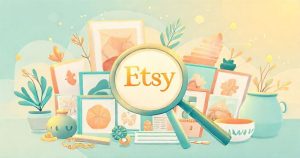Etsy stands as a prominent global marketplace, celebrated for its unique collection of handmade, vintage, and craft supply items. It offers a vibrant ecosystem where creators can connect directly with customers seeking distinctive goods not found in mainstream retail. Understanding the diverse product landscape on Etsy is crucial for both aspiring sellers and curious buyers. This exploration delves into the various product types that thrive on the platform, examines factors influencing their success, and provides insights into identifying profitable niches. Whether you are looking to purchase a one-of-a-kind gift or considering starting your own creative venture, a comprehensive understanding of Etsy’s offerings is invaluable.
Understanding the Etsy Marketplace: A Hub for Unique Creations
Etsy’s distinctiveness lies in its unwavering focus on individuality and craftsmanship. Unlike conventional e-commerce platforms, it fosters a community that values the story behind each item and the skill of the maker. This environment naturally attracts buyers actively searching for personalized gifts, bespoke home decor, or rare vintage finds. For sellers, it provides a dedicated audience appreciative of handmade quality and ethical sourcing. The platform’s structure supports a wide array of products, from intricate jewelry pieces to instantly downloadable digital art, creating a dynamic marketplace rich with opportunity.
Exploring Popular Product Categories on Etsy
The vast selection of items available on Etsy can be broadly categorized, each offering distinct appeal and market potential. Recognizing these categories helps in understanding the platform’s diverse offerings and pinpointing areas of interest. From tangible, handcrafted goods to intangible digital downloads, Etsy accommodates a broad spectrum of creative endeavors. Each category presents unique challenges and rewards, catering to different skill sets and customer demands, thereby enriching the overall marketplace experience for everyone involved.
Handmade Goods: Craftsmanship at its Core
Handmade items form the very soul of Etsy, encompassing a broad range of products meticulously crafted by artisans. This category includes everything from intricate jewelry, often priced from $20 to $200 depending on materials and complexity, to custom apparel, which can range from $30 for a t-shirt to $300 for a unique dress. Home decor items, such as ceramic pieces or personalized wall art, frequently sell between $50 and $500. The appeal of handmade goods lies in their unique nature, the story of their creation, and the personal touch that mass-produced items lack, making them highly sought after.
Digital Products: The Realm of Instant Downloads
Digital products represent a highly scalable and often very profitable segment on Etsy. These include items like printable planners, digital artwork, logo templates, social media kits, and unique fonts. Sellers benefit from zero inventory costs and automated delivery, allowing for high-volume sales with minimal ongoing effort after initial creation. Pricing for digital products typically ranges from $5 for a simple printable to $50 or more for comprehensive template bundles. This category appeals greatly to buyers seeking instant access to resources for personal projects, business branding, or home organization, offering both convenience and value.
Vintage Items: Curated Treasures with History
Etsy is also a treasure trove for vintage enthusiasts, featuring items that are at least 20 years old. This category includes anything from retro fashion and accessories to antique home furnishings and collectibles. Sourcing these unique items requires a keen eye and often involves visiting flea markets, estate sales, or online auctions. Prices for vintage items vary widely based on rarity, condition, and desirability, from $10 for a small trinket to several hundred dollars for a rare piece of furniture. Buyers appreciate the historical value, unique aesthetic, and sustainable aspect of giving new life to pre-loved goods.
Craft Supplies: Fueling Creativity Worldwide
For those who love to create, Etsy offers an extensive selection of craft supplies. This includes a vast array of beads, fabrics, specialized tools, yarns, and other materials necessary for various DIY projects. Sellers in this category often cater to other artisans and hobbyists, providing unique or hard-to-find components. The pricing structure for craft supplies is usually competitive, with small batches or individual items costing a few dollars, while larger quantities or specialized tools can be significantly more. This niche supports the broader creative community on Etsy, ensuring a steady supply of materials for makers.
Identifying High-Demand and Niche Etsy Products
Success on Etsy often hinges on identifying what buyers are actively seeking and understanding how to cater to specific underserved markets. This strategic approach moves beyond simply offering products and focuses on thoughtful market analysis. By consistently monitoring trends and recognizing the unique preferences of particular customer segments, sellers can position their offerings to stand out in a competitive environment. This requires a blend of creativity, research, and a clear understanding of the platform’s dynamics and its diverse user base.
Analyzing Market Trends for Etsy Success
Staying abreast of current market trends is vital for any Etsy seller aiming for sustained success. Trends can be seasonal, such as holiday-themed decor or summer wedding accessories, or they can be driven by broader cultural shifts, like increased demand for sustainable products or personalized items. Regularly exploring Etsy’s own trend reports, monitoring social media, and observing popular culture can provide invaluable insights. Adapting product lines to align with these emerging demands ensures relevance and appeals to a wider, engaged audience. This proactive approach helps in maintaining a fresh and appealing inventory.
The Power of Niche: Tapping into Specific Audiences
While broad categories have their appeal, the true potential for profitability often lies within specific niches. Focusing on a narrow, well-defined audience allows sellers to create highly targeted products that resonate deeply with a particular group. Examples include bespoke pet accessories, custom wedding stationery for specific themes, or eco-friendly gifts for conscious consumers. By understanding the precise needs and desires of a niche market, sellers can build a strong brand identity and foster a loyal customer base. This targeted approach often leads to higher conversion rates and stronger customer relationships.
Factors Influencing Product Profitability on Etsy
Achieving profitability on Etsy involves more than just creating appealing products; it requires a strategic understanding of various business elements. From setting competitive prices to efficiently managing production, every decision impacts the bottom line. Sellers must carefully consider their costs, market positioning, and the perceived value of their offerings to ensure sustainable growth. A holistic approach that integrates quality, efficiency, and smart marketing is fundamental to turning creative passion into a successful commercial venture within the Etsy ecosystem.
Pricing Strategies: Balancing Value and Competitiveness
Effective pricing is a critical component of profitability. Sellers must carefully calculate material costs, labor hours, Etsy fees, and packaging expenses to determine a base price. Beyond cost, understanding perceived value and competitive pricing is essential. Researching similar items on Etsy and analyzing their pricing structure helps in positioning products competitively while ensuring adequate profit margins. Offering tiered pricing, bundle deals, or occasional promotions can also attract buyers without devaluing the product. A well-thought-out pricing strategy directly influences both sales volume and overall financial success.
Production Efficiency and Material Sourcing
The efficiency of production and the cost of materials significantly impact profitability. Streamlining the creation process, whether through optimized crafting techniques for handmade items or efficient design workflows for digital products, reduces labor costs. Sourcing materials wisely, perhaps by buying in bulk or finding reliable, affordable suppliers, directly improves profit margins. For print-on-demand products, selecting a cost-effective and reliable fulfillment partner is paramount. Maximizing efficiency and optimizing sourcing minimizes overheads, allowing for greater financial returns on each sale.
Marketing and Branding: Standing Out in a Crowded Market
Even the most unique products require effective marketing and strong branding to capture attention on Etsy. High-quality product photography, compelling descriptions, and strategic use of relevant keywords are foundational. Developing a consistent brand identity – from shop banner to packaging – helps establish recognition and trust. Engaging with customers through excellent service and responding to inquiries promptly also contributes to a positive brand image. While not directly a cost, effective marketing and branding efforts drive traffic and conversions, thereby enhancing overall profitability and shop visibility.
Etsy Product Comparison: Handmade vs. Digital vs. Print-on-Demand
When considering what to sell on Etsy, prospective sellers often weigh the merits of different product types. Each category—handmade, digital, and print-on-demand—presents a unique set of advantages and disadvantages in terms of initial investment, scalability, and the level of ongoing effort required. Understanding these differences is crucial for aligning a business model with personal resources and long-term goals. This comparative analysis helps in making an informed decision about which product type best suits an individual’s skills, capital, and desired business structure within the Etsy marketplace.
Handmade Items: Craft, Investment, and Personal Touch
Handmade items demand significant time, skill, and often a substantial initial investment in materials and tools. For instance, creating intricate jewelry requires specialized equipment and precious metals, while custom apparel involves fabric, sewing machines, and design expertise. The scalability can be limited by the maker’s capacity and time, as each item is unique. However, handmade products command higher price points due to their artisanal quality and personalized nature, often leading to strong customer loyalty and a powerful narrative behind each purchase. The personal connection is a significant selling point.
Digital Products: Low Overhead, High Scalability
Digital products, such as planners, templates, or artwork, typically require a lower initial investment, mainly in design software and creative time. Once created, they can be sold repeatedly without needing to replenish physical inventory or manage shipping. This offers immense scalability, allowing sellers to generate passive income from a single creation. While individual item prices are generally lower than handmade goods, the potential for high-volume sales makes them extremely profitable. The primary challenge lies in effective marketing and standing out in a crowded digital marketplace with unique, high-quality offerings.
Print-on-Demand Products: Design Focus, Outsourced Production
Print-on-demand (POD) items involve designing graphics or text that are then printed onto products like t-shirts, mugs, or phone cases by a third-party manufacturer only after a sale is made. This model significantly reduces inventory risk and production effort for the seller, as they primarily focus on design and marketing. Initial investment is minimal, often just for design tools. While profit margins per item might be lower compared to handmade goods, the scalability is high, similar to digital products. The seller maintains creative control while outsourcing the manufacturing and shipping logistics, balancing creativity with efficiency.
Conclusion: Crafting a Path to Etsy Success
Navigating the diverse world of Etsy products requires a blend of creativity, strategic thinking, and continuous market awareness. From understanding the unique appeal of handmade goods to leveraging the scalability of digital and print-on-demand items, success hinges on identifying the right product for the right audience. By focusing on niche markets, implementing intelligent pricing strategies, and efficiently managing production, sellers can cultivate thriving businesses. Buyers, in turn, benefit from a marketplace brimming with unique, high-quality items. Ultimately, thorough research, commitment to quality, and a passion for unique offerings pave the way for a rewarding Etsy journey.




